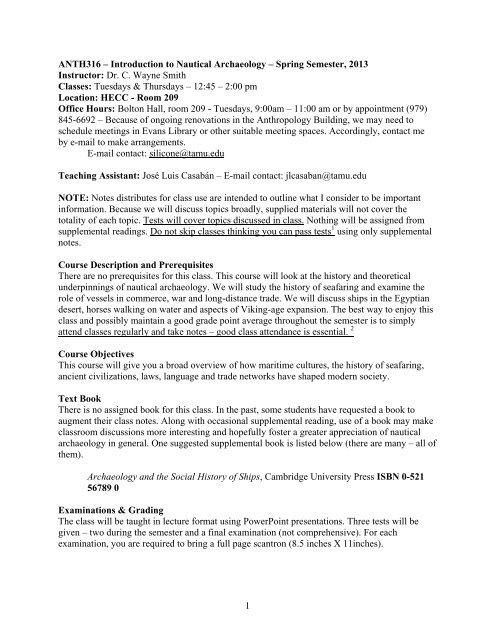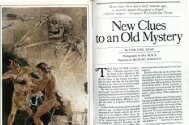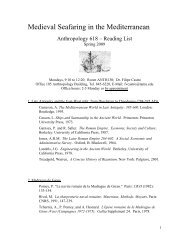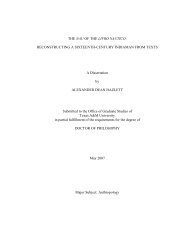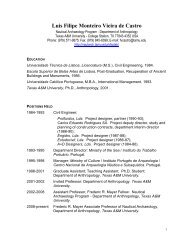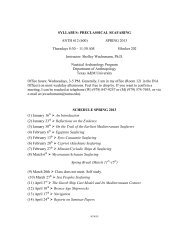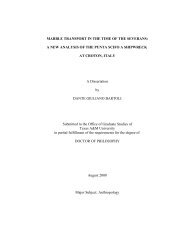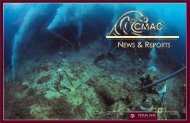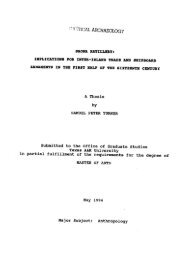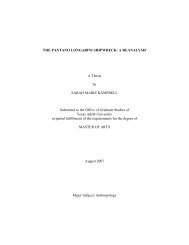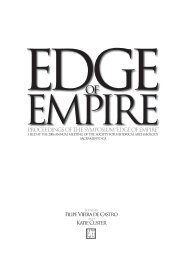Syllabus - Nautical Archaeology at Texas A&M University
Syllabus - Nautical Archaeology at Texas A&M University
Syllabus - Nautical Archaeology at Texas A&M University
You also want an ePaper? Increase the reach of your titles
YUMPU automatically turns print PDFs into web optimized ePapers that Google loves.
ANTH316 – Introduction to <strong>Nautical</strong> <strong>Archaeology</strong> – Spring Semester, 2013<br />
Instructor: Dr. C. Wayne Smith<br />
Classes: Tuesdays & Thursdays – 12:45 – 2:00 pm<br />
Loc<strong>at</strong>ion: HECC - Room 209<br />
Office Hours: Bolton Hall, room 209 - Tuesdays, 9:00am – 11:00 am or by appointment (979)<br />
845-6692 – Because of ongoing renov<strong>at</strong>ions in the Anthropology Building, we may need to<br />
schedule meetings in Evans Library or other suitable meeting spaces. Accordingly, contact me<br />
by e-mail to make arrangements.<br />
E-mail contact: silicone@tamu.edu<br />
Teaching Assistant: José Luis Casabán – E-mail contact: jlcasaban@tamu.edu<br />
NOTE: Notes distributes for class use are intended to outline wh<strong>at</strong> I consider to be important<br />
inform<strong>at</strong>ion. Because we will discuss topics broadly, supplied m<strong>at</strong>erials will not cover the<br />
totality of each topic. Tests will cover topics discussed in class. Nothing will be assigned from<br />
supplemental readings. Do not skip classes thinking you can pass tests 1 using only supplemental<br />
notes.<br />
Course Description and Prerequisites<br />
There are no prerequisites for this class. This course will look <strong>at</strong> the history and theoretical<br />
underpinnings of nautical archaeology. We will study the history of seafaring and examine the<br />
role of vessels in commerce, war and long-distance trade. We will discuss ships in the Egyptian<br />
desert, horses walking on w<strong>at</strong>er and aspects of Viking-age expansion. The best way to enjoy this<br />
class and possibly maintain a good grade point average throughout the semester is to simply<br />
<strong>at</strong>tend classes regularly and take notes – good class <strong>at</strong>tendance is essential. 2<br />
Course Objectives<br />
This course will give you a broad overview of how maritime cultures, the history of seafaring,<br />
ancient civiliz<strong>at</strong>ions, laws, language and trade networks have shaped modern society.<br />
Text Book<br />
There is no assigned book for this class. In the past, some students have requested a book to<br />
augment their class notes. Along with occasional supplemental reading, use of a book may make<br />
classroom discussions more interesting and hopefully foster a gre<strong>at</strong>er appreci<strong>at</strong>ion of nautical<br />
archaeology in general. One suggested supplemental book is listed below (there are many – all of<br />
them).<br />
<strong>Archaeology</strong> and the Social History of Ships, Cambridge <strong>University</strong> Press ISBN 0-521<br />
56789 0<br />
Examin<strong>at</strong>ions & Grading<br />
The class will be taught in lecture form<strong>at</strong> using PowerPoint present<strong>at</strong>ions. Three tests will be<br />
given – two during the semester and a final examin<strong>at</strong>ion (not comprehensive). For each<br />
examin<strong>at</strong>ion, you are required to bring a full page scantron (8.5 inches X 11inches).<br />
1
Each test consists of fifty (50) questions. Each test counts for thirty percent (30%) of your grade.<br />
The final ten percent of your total grade will be taken from two (2) pop quizzes, each worth 5%.<br />
We will have four pop quizzes throughout the semester – your top two (2) scores will be used to<br />
determine your final grade. Rescheduling exams is complic<strong>at</strong>ed – unless you have a<br />
university sanctioned activity or medical slip, please do not ask to have an altern<strong>at</strong>e test<br />
schedule.<br />
Grading<br />
90-100% A<br />
80-89% B<br />
70-79% C<br />
60-69% D<br />
59 and below F<br />
Missing Exams, Assignments and Classes<br />
Anyone missing a scheduled examin<strong>at</strong>ion or pop quiz due to a sanctioned university activity,<br />
may complete the missed examin<strong>at</strong>ion or quiz within 30 calendar days from the last day of the<br />
absence. Absence from classes and labs will be accepted for students who have legitim<strong>at</strong>e<br />
excuses as defined in the TAMUS Student Rules, specifically Rule 7 (http://studentrules.tamu.edu/rule07).<br />
Exam Schedule: use an 8.5X11 scantron for all exams<br />
First Examin<strong>at</strong>ion - February 19 - regular class time (8.5 X 11)<br />
Second Examin<strong>at</strong>ion - March 19 - regular class time (8.5 X 11)<br />
Third and Final Examin<strong>at</strong>ion – May 8, 2013 (2 hour) (bring full page scantron (8.5 X 11)<br />
Reminder – do not skip classes 3<br />
Tent<strong>at</strong>ive Lecture Schedule – Changes are Inevitable<br />
January 14, 2013 – first day of classes <strong>at</strong> TAMU<br />
January 15 - First Class – please take notes<br />
<strong>Nautical</strong> <strong>Archaeology</strong>: discipline, Techniques and Technologies<br />
Survey, excav<strong>at</strong>ions, mapping techniques, conserv<strong>at</strong>ion reconstruction, and analysis of<br />
artifacts and sites<br />
Intent - to outline basic areas of the discipline<br />
January 17 class 2<br />
Ships and Seafaring in the Bronze Age Mediterranean<br />
Iconography – Predynastic Egyptian ships and seafaring<br />
Intent-look <strong>at</strong> drawings as texts we can read and compare them to a real vessel<br />
January 22 class 3<br />
Kufu and the Gre<strong>at</strong> Pyramid<br />
Intent-look <strong>at</strong> drawings as texts we can read and compare them to a real vessel<br />
2
January 24 class 4<br />
Dashur Bo<strong>at</strong>s - We will discuss ‘the ship” as icon, the role of ships in religious<br />
ceremonies and why we find ships in terrestrial settings.<br />
Intent – compare working funerary craft to th<strong>at</strong> of a deity<br />
January 29 class 5<br />
Ship in Burials – Cheops – Sutton Hoo<br />
So not th<strong>at</strong> we need to move people and goods, how do we start?<br />
Intent - Icons, mythology and sources of inform<strong>at</strong>ion. Can a clay pot tell a story<br />
January 31 class 6<br />
L<strong>at</strong>e Bronze Age Shipwrecks <strong>at</strong> Cape Gelidonya, Cape of wh<strong>at</strong> you say?<br />
Intent - This class will look <strong>at</strong> the humble beginnings of underw<strong>at</strong>er excav<strong>at</strong>ions.<br />
February 5 class 7<br />
Uluburun Shipwreck<br />
Today we run the gamut of ideas including ox hide ingots and computer technologies.<br />
Intent – Cape Gelidonia started the ball rolling – Uluburun expands the idea of early trade<br />
February 7 class 8<br />
Greek Merchantmen (may be substituted)<br />
Intent – the expand the picture of Western Mediterranean trade<br />
February 12 class 9<br />
Ships and Seafaring during the Archaic and Classical Period<br />
February 14 class 10<br />
Kyrenia Shipwreck – Film – Take notes because this m<strong>at</strong>erial will be on the exam.<br />
Intent - In this class, we will discuss archaeological processes and some of the important consider<strong>at</strong>ions th<strong>at</strong><br />
made these excav<strong>at</strong>ions so successful.<br />
February 19 class 11- FIRST EXAMINATION - bring a full page scantron (8.5 X 11)<br />
February 21 class 12<br />
Roman Ships and Seafaring<br />
Intent – rise of urban centers and the rise of citizen needs<br />
February 26 class 13<br />
Early Mediterranean warships<br />
Intent - All roads lead to Rome, <strong>at</strong> least in this class. We will look <strong>at</strong> gre<strong>at</strong> ships th<strong>at</strong> had libraries,<br />
gymnasiums, and many important design ideas.<br />
February 28 class 14<br />
Anchors and Roman Harbors<br />
Intent - ideas last a long time. Today’s class will look a moving goods and people and how the need to<br />
transport m<strong>at</strong>erials continues to affect the designs of w<strong>at</strong>ercraft.<br />
3
March 5 class 15<br />
Yassiada 7 th century shipwreck - Early Medieval Ships and Seafaring in the<br />
Mediterranean<br />
Intent - Today we look <strong>at</strong> the ‘story power’ of an assemblage of artifacts.<br />
March 7 class 16<br />
L<strong>at</strong>e Medieval Ships and Seafaring in the Mediterranean - Serce Limani Shipwreck<br />
Intent – Glass, glass and more glass – ships, people, and ideas of commerce<br />
March 11-15 - SPRING BREAK – NO CLASSES<br />
March 19 class 17 - SECOND EXAMINATION - bring a full page scantron (8.5 X 11)<br />
March 21 class 18<br />
Early Viking Ships<br />
A film on Lief Eriksson will be shown. This is a fun film. You will be amazed by I<br />
Icelandic Sagas, the beginnings of our legal system and lapstrake vessel construction.<br />
Take notes because this will be on the exam.<br />
March 26 class 19<br />
Scandinavian and Early Medieval Ships and Seafaring in Northern Europe<br />
Iconography and study of Nordic Traditions<br />
Intent - From burial sites on land to a castle mo<strong>at</strong>, we will look <strong>at</strong> several vessels and their unique<br />
assemblages of artifacts.<br />
March 28 class 20<br />
Skuldelev Ships<br />
This is a big lecture and may be divided into a film class and a lecture class.<br />
Intent - Amazing technologies th<strong>at</strong> Texans have adopted for excav<strong>at</strong>ions off the coast of <strong>Texas</strong>.<br />
April 2 class 21<br />
Hulks, Cogs and Carracks<br />
Time permitting; we will spend a lot of time looking <strong>at</strong> these vessels.<br />
Intent - a brief look <strong>at</strong> the diversity of w<strong>at</strong>er craft designed to expand trade and travels<br />
April 4 class 22<br />
The Gre<strong>at</strong> Ship Vasa - movie<br />
The story of the Vasa is one of majesty and tragedy. The design of this vessel affirms<br />
why we should all be kings and queens. Take many notes.<br />
Intent – lots to be learned about integrity, the blame game and who should not build ships<br />
April 9 class 23<br />
The Mary Rose<br />
How one of England’s top archaeologists excav<strong>at</strong>ed and recovered a magnificent flo<strong>at</strong>ing<br />
fortress.<br />
Intent – women in archaeology, the role of technology and much more<br />
4
April 11 class 24<br />
Excav<strong>at</strong>ions <strong>at</strong> Seventeenth Century Port Royal, Jamaica<br />
This class is about ten years of excav<strong>at</strong>ions by TAMU professors and field school<br />
students. This English settlement was known as the ‘wickedest city in Christendom.’<br />
April 16 class 25<br />
When Horses Walked on W<strong>at</strong>er – Burlington, Vermont Horse Ferry, the work of Dr.<br />
Kevin Crisman, <strong>Texas</strong> A&M <strong>University</strong><br />
Intent – archaeology does not just cover c<strong>at</strong>astrophes<br />
April 18 class 26<br />
H.L. Hunley and the Silent Service - submarine<br />
Intent – aspects of the Civil Way you may not have considered<br />
April 23 class 27<br />
USS Monitor and the Monitor N<strong>at</strong>ional Marine<br />
Intent - New vessels and new naval str<strong>at</strong>egies<br />
April 25 class 28 FINAL EXAM REVIEW and Mystery Talk<br />
This is a special day because I will answer any questions you have to prepare for the final<br />
exam. After the class is dismissed, many students stay for my ‘mystery talk.’ This is<br />
optional and has no bearing wh<strong>at</strong>soever on class content or exams. In the past, students<br />
have found this talk to be inspir<strong>at</strong>ional.<br />
April 30 - NO CLASS – REDEFINED DAY (Friday classes)<br />
May 8, 2013 FINAL EXAM (EXAM 3) 2 hours allotted - (bring full page scantron)<br />
The Americans with Disabilities Act (ADA)<br />
The Americans with Disabilities Act (ADA) is a federal anti-discrimin<strong>at</strong>ion st<strong>at</strong>ute th<strong>at</strong> provides<br />
comprehensive civil rights protection for persons with disabilities. Among other things, this<br />
legisl<strong>at</strong>ion requires th<strong>at</strong> all students with disabilities be guaranteed a learning environment th<strong>at</strong><br />
provides for reasonable accommod<strong>at</strong>ion of their disabilities. If you believe you have a disability<br />
requiring an accommod<strong>at</strong>ion, please contact Disability Services, in Cain Hall, Room B118, or<br />
call 845-1637. For additional inform<strong>at</strong>ion visit http://disability.tamu.edu.<br />
TAMU Plagiarism Policy<br />
The handouts used in this course are copyrighted. By "handouts," I mean all m<strong>at</strong>erials<br />
gener<strong>at</strong>ed for this class, which include but are not limited to syllabi, quizzes, exams, lab<br />
problems, in-class m<strong>at</strong>erials, review sheets, and additional problem sets. Because these<br />
m<strong>at</strong>erials are copyrighted, you do not have the right to copy the handouts, unless I<br />
expressly grant permission. As commonly deemed, plagiarism consists of passing off as<br />
one's own the ideas, words, writings, etc., which belong to another. In accordance with<br />
this definition, you are committing plagiarism if you copy the work of another person and<br />
turn it in as your own, even if you should have the permission of th<strong>at</strong> person. Plagiarism<br />
is one of the worst academic sins, for the plagiarist destroys the trust among colleagues<br />
5
without which research cannot be safely communic<strong>at</strong>ed. If you have any questions<br />
regarding plagiarism, please consult the l<strong>at</strong>est issue of the <strong>Texas</strong> A&M <strong>University</strong><br />
Student Rules, under the section "Scholastic Dishonesty.”<br />
Academic Integrity - Aggie Code of Honor<br />
‘An Aggie does not lie, che<strong>at</strong>, or steal or toler<strong>at</strong>e those who do.’ The Aggie Code of<br />
Honor is an effort to unify the aims of all <strong>Texas</strong> A&M men and women toward a high<br />
code of ethics and personal dignity. Foremost, living under this code will be no problem,<br />
as it asks nothing of a person th<strong>at</strong> is beyond reason. It only calls for honesty and integrity,<br />
characteristics th<strong>at</strong> Aggies have always exemplified. The Aggie Code of Honor functions<br />
as a symbol to all Aggies, promoting understanding and loyalty to truth and confidence in<br />
each other. http://www.tamu.edu/aggiehonor<br />
In the recent past numerous students have waited until l<strong>at</strong>e in the semester to come and discuss<br />
problems th<strong>at</strong> they are having in their studies. The end of the semester is usually too l<strong>at</strong>e to help<br />
someone improve his or her grade potential. Come early in the semester and we will try to assist<br />
you. I do not give extra assignments to help students improve their grades. This is not fair to<br />
other students in the class. Pop quizzes are given <strong>at</strong> the end of class. If you come and report th<strong>at</strong><br />
you missed a quiz, this means you also missed the lecture. Get notes from someone in class and<br />
if you have a doctor’s note or official university activity absence slip, you must make up the<br />
missed exam / quiz within 30 calendar days from the last day of the absence.<br />
6


